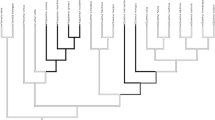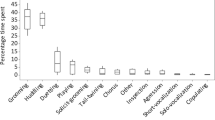Abstract
Horses are phylogenetically distant from primates, but considerable behavioral links exist between the two. The sociality of horses, characterized by group stability, is similar to that of primates, but different from that of many other ungulates. Although horses and primates are good models for exploring the evolution of societies in human and non-human animals, fewer studies have been conducted on the social system of horses than primates. Here, we investigated the social system of feral horses, particularly the determinant factors of single-male/multi-male group dichotomy, in light of hypotheses derived from studies of primate societies. Socioecological data from 26 groups comprising 208 feral horses on Serra D’Arga, northern Portugal suggest that these primate-based hypotheses cannot adequately explain the social system of horses. In view of the sympatric existence of multi- and single-male groups, and the frequent intergroup transfers and promiscuous mating of females with males of different groups, male–female relationships of horses appear to differ from those of polygynous primates.


Similar content being viewed by others
References
Álvares F (2011) Wolf ecology and conservation in northwest Portugal. PhD thesis in biology (conservation biology), University of Lisbon (in Portuguese)
Asa CS (1986) Sexual behavior of mares. In: Crowell Davis SL, Houpt KA (eds) The veterinary clinics of North America: equine practice, 2nd edn. Saunders, Philadelphia, pp 519–534
Bowling AT, Touchberry RW (1990) Parentage of Great Basin feral horses. J Wildl Manage 54:424–429
Cameron EZ, Linklater WL, Stafford KJ, Minot EO (2003) Social grouping and maternal behaviour in feral horses (Equus caballus): the influence of males on maternal protectiveness. Behav Ecol Sociobiol 53:92–101
Cameron EZ, Setsaas TH, Linklater WL (2009) Social bonds between unrelated females increase reproductive success in feral horses. Proc Natl Acad Sci USA 106:13850–13853
Clutton-Brock TH, Harvey PH (1977) Primate ecology and social organization. J Zool 183:1–39
De Waal FB (2003) Silent invasion: Imanishi’s primatology and cultural bias in science. Anim Cogn 6:293–299
Goodloe RB, Warren RJ, Osborn DA, Hall C (2000) Population characteristics of feral horses on Cumberland Island, Georgia and their management implications. J Wildl Manage 64:114–121
Gray ME, Cameron EZ, Peacock MM, Thain DS, Kirchoff VS (2012) Are low infidelity rates in feral horses due to infanticide? Behav Ecol Sociobiol 66:529–537
Imanishi K (1953) Social life of semi-wild horses in Toimisaki. Annu Anim Psychol 3:11–31
Kappeler PM, van Schaik CP (2002) Evolution of primate social systems. Int J Primatol 23:707–740
Linklater WL (2000) Adaptive explanation in socio-ecology: lessons from the Equidae. Biol Rev Camb Philos Soc 75:1–20
Linklater WL, Cameron EZ (2000) Tests for cooperative behaviour between stallions. Anim Behav 60:731–743
Marjamäki PH, Contasti AL, Coulson TN, McLoughlin PD (2013) Local density and dispersal in a polygynous mammal. Ecol Evol 3:3073–3082
Matsuzawa T, McGrew WC (2008) Kinji Imanishi and 60 years of Japanese primatology. Curr Biol 18:R587–R591
Mills DS, McDonnell SM (2005) The domestic horse: the origins, development and management of its behaviour. Cambridge University Press, Cambridge
Mitani JC, Gros-Louis J, Manson JH (1996) Number of males in primate groups: comparative tests of competing hypotheses. Am J Primatol 38:315–332
Monard AM, Duncan P, Boy V (1996) The proximate mechanisms of natal dispersal in female horses. Behaviour 133:1095–1124
Morais J, Oom MM, Malta-Vacas J, Luís C (2005) Genetic structure of an endangered Portuguese semiferal pony breed, the Garrano. Biochem Genet 43:347–364
Nunn CL (1999) The number of males in primate social groups: a comparative test of the socioecological model. Behav Ecol Sociobiol 46:1–13
Ringhofer M, Yamamoto S (2017) Domestic horses send signals to humans when they are faced with an unsolvable task. Anim Cogn 20:397–405
Stevens EF (1990) Instability of harems of feral horses in relation to season and presence of subordinate stallions. Behaviour 112:149–161
Tomonaga M, Kumazaki K, Camus F, Nicod S, Pereira C, Matsuzawa T (2015) A horse’s eye view: size and shape discrimination compared with other mammals. Biol Lett 11:20150701. doi:10.1098/rsbl.2015.0701
Van Schaik CP, Hörstermann M (1994) Predation risk and the number of adult males in a primate group: a comparative test. Behav Ecol Sociobiol 35:261–272
Van Schaik CP, Kappeler PM (1997) Infanticide risk and the evolution of male–female association in primates. Proc Biol Sci 264:1687–1694
Acknowledgements
The field observations complied with the guidelines for animal studies in the wild of the Wildlife Research Center of Kyoto University, Japan. Special thanks are due to the municipality of Viana do Castelo for supporting our project. We are grateful to Agostinho Costinha, the director of Descubra Minho, Lourenço Almada of the Associação O Caminho do Garrano, and the villagers in Montaria for their support during our stay. The study was financially supported by grants from the Japan Society for the Promotion of Science (JSPS core-to-core CCSN and JSPS-U04 to T. M., KAKENHI Nos. 15H01619, 15H05309, and 17H05862 to S. Y.) and the Ministry of Education, Culture, Sports, Science and Technology of Japan (MEXT No. 16H06283 to T. M.).
Author information
Authors and Affiliations
Corresponding authors
Ethics declarations
Conflict of interest
The authors declare that they have no conflict of interest.
Electronic supplementary material
Below is the link to the electronic supplementary material.
About this article
Cite this article
Ringhofer, M., Inoue, S., Mendonça, R.S. et al. Comparison of the social systems of primates and feral horses: data from a newly established horse research site on Serra D’Arga, northern Portugal. Primates 58, 479–484 (2017). https://doi.org/10.1007/s10329-017-0614-y
Received:
Accepted:
Published:
Issue Date:
DOI: https://doi.org/10.1007/s10329-017-0614-y




